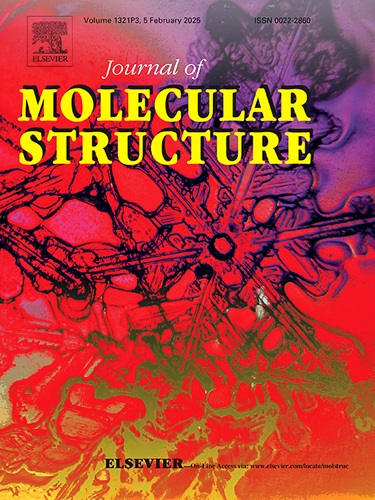Synthesis, characterization of europium(III) and terbium(III) complexes containing lawsone ligand and their interaction with DNA, HSA, and topoisomerases
IF 4
2区 化学
Q2 CHEMISTRY, PHYSICAL
引用次数: 0
Abstract
In this study, two complexes based on Europium [Eu(LAW)3(H2O)3] (1) and Terbium [Tb(LAW)3(H2O)3] (2), each containing the lawsone ligand, were synthesized and comprehensively characterized using Infrared and UV-Visible spectroscopies, Cyclic Voltammetry, Conductivity, and Magnetic Susceptibility measurements. Crystal structure information was determined via X-ray diffraction (XRD), and elemental analysis confirmed the compounds’ purity. Experimental and theoretical UV-Vis data were compared through TD-DFT calculations, providing insights into the low luminescence of both Eu(III) and Tb(III) complexes, with excited states calculated both with and without solvent effects. DNA-binding experiments with ct-DNA were conducted using viscosity measurements, UV-Vis titrations, circular dichroism, and fluorescence competition assays to explore the complexes' primary interactions with the DNA target. Additionally, DNA cleavage properties were examined using pBR322 plasmid DNA with agarose gel electrophoresis. Although no cleavage activity was observed, DNA interaction studies suggested covalent binding, supported by viscosity and circular dichroism data. Furthermore, analyzing the docking results, both compounds demonstrated stable conformations within the Sudlow I site also the lawsone-based compounds demonstrated an ability to bind to human serum albumin (HSA) with binding constants (Kb) in the range of 105-106 and showed Topoisomerase IIα inhibition at 50 µM. Both compounds remained stable for up to 48 hours.

求助全文
约1分钟内获得全文
求助全文
来源期刊

Journal of Molecular Structure
化学-物理化学
CiteScore
7.10
自引率
15.80%
发文量
2384
审稿时长
45 days
期刊介绍:
The Journal of Molecular Structure is dedicated to the publication of full-length articles and review papers, providing important new structural information on all types of chemical species including:
• Stable and unstable molecules in all types of environments (vapour, molecular beam, liquid, solution, liquid crystal, solid state, matrix-isolated, surface-absorbed etc.)
• Chemical intermediates
• Molecules in excited states
• Biological molecules
• Polymers.
The methods used may include any combination of spectroscopic and non-spectroscopic techniques, for example:
• Infrared spectroscopy (mid, far, near)
• Raman spectroscopy and non-linear Raman methods (CARS, etc.)
• Electronic absorption spectroscopy
• Optical rotatory dispersion and circular dichroism
• Fluorescence and phosphorescence techniques
• Electron spectroscopies (PES, XPS), EXAFS, etc.
• Microwave spectroscopy
• Electron diffraction
• NMR and ESR spectroscopies
• Mössbauer spectroscopy
• X-ray crystallography
• Charge Density Analyses
• Computational Studies (supplementing experimental methods)
We encourage publications combining theoretical and experimental approaches. The structural insights gained by the studies should be correlated with the properties, activity and/ or reactivity of the molecule under investigation and the relevance of this molecule and its implications should be discussed.
 求助内容:
求助内容: 应助结果提醒方式:
应助结果提醒方式:


